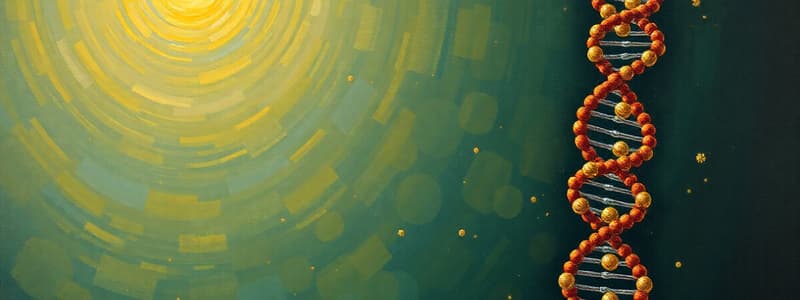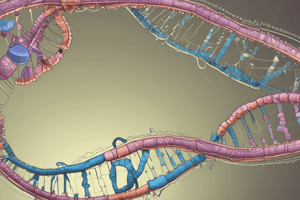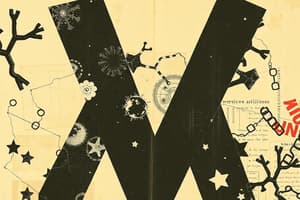Podcast
Questions and Answers
What is the role of RNA polymerase in transcription?
What is the role of RNA polymerase in transcription?
- RNA polymerase breaks peptide bonds between amino acids in a polypeptide chain.
- RNA polymerase breaks hydrogen bonds between base pairs in DNA. (correct)
- RNA polymerase guides the pairing of tRNA anticodons with mRNA codons.
- RNA polymerase adds new nucleotides to the growing mRNA strand. (correct)
What is the difference between a codon and an anticodon?
What is the difference between a codon and an anticodon?
- Codons determine the sequence of amino acids in a protein, while anticodons determine the sequence of nucleotides in DNA.
- Codons are made of 3 nucleotides, while anticodons are made of 2 nucleotides.
- Codons are always found in the nucleus, while anticodons are always found in the cytoplasm.
- Codons are found on mRNA, while anticodons are found on tRNA. (correct)
Which of the following is NOT a step in translation?
Which of the following is NOT a step in translation?
- DNA unzips and separates. (correct)
- Amino acids are linked together by peptide bonds to form a protein.
- tRNA brings amino acids to the ribosome.
- mRNA leaves the nucleus and travels to a ribosome.
What is the function of a stop codon?
What is the function of a stop codon?
Which of the following describes the process of transcription?
Which of the following describes the process of transcription?
What is the primary difference between DNA and RNA?
What is the primary difference between DNA and RNA?
Where in the cell does transcription take place?
Where in the cell does transcription take place?
Which of the following is a true statement about the relationship between DNA and RNA?
Which of the following is a true statement about the relationship between DNA and RNA?
Flashcards
Translation
Translation
The process of using mRNA to synthesize proteins at the ribosomes.
mRNA
mRNA
A type of RNA that carries the genetic information from DNA to the ribosome for protein synthesis.
Codon
Codon
A sequence of three mRNA nucleotides that codes for a specific amino acid.
Anticodon
Anticodon
Signup and view all the flashcards
Start Codon
Start Codon
Signup and view all the flashcards
Stop Codon
Stop Codon
Signup and view all the flashcards
Peptide Bond
Peptide Bond
Signup and view all the flashcards
RNA Polymerase
RNA Polymerase
Signup and view all the flashcards
Study Notes
Protein Synthesis Overview
- Protein synthesis is a two-part process: transcription and translation
- The goal is to create https://www.canva.com/design/DAGdmuGr_ds/Q39nEfCRhEMmz65Ny6PCYQ/view?utm_content=DAGdmuGr_ds&utm_campaign=designshare&utm_medium=link2&utm_source=uniquelinks&utlId=h68258c788c from DNA
- Transcription occurs in the nucleus
- Translation occurs at ribosomes in the cytoplasm
Transcription
- Making mRNA from DNA
- Takes place in the nucleus
- Steps:
- DNA "unzips"
- RNA polymerase breaks hydrogen bonds between base pairs
- Free-floating RNA nucleotides attach to DNA bases on one side of the DNA molecule
- Covalent bonds form between sugars and phosphates on the mRNA strand
- mRNA molecule is released and DNA "zips" back up
- RNA polymerases (enzymes) guide transcription by reading the DNA code
RNA vs. DNA
- DNA contains thymine; RNA contains uracil
- DNA is double-stranded; RNA is single-stranded
- DNA's sugar is deoxyribose; RNA's sugar is ribose
- DNA stays in the nucleus; RNA travels between the nucleus and cytoplasm.
- DNA has one type, and RNA has three types: mRNA, tRNA, rRNA
RNA Importance
- mRNA (messenger RNA) takes the code out to the ribosomes
- tRNA (transfer RNA) brings amino acids to the ribosomes to create proteins
- Information is transferred from DNA to RNA to proteins; this is the central dogma of molecular biology
Translation
- Using mRNA to make proteins
- Occurs at ribosomes
- Steps:
- mRNA leaves nucleus and travels to ribosomes (site of protein synthesis)
- Amino acids are brought to the ribosome by tRNA.
- tRNA bases (anticodons) pair with mRNA bases (codons).
- Amino acids join by peptide bonds to form proteins (polypeptides)
Translation Terms
- Proteins are made of amino acids
- The order of bases determines which amino acids are used.
- 3 mRNA nucleotides = codon
- 3 tRNA nucleotides = anticodon
- 3 bases code for 1 amino acid
- Anticodons are specific to certain amino acids
- Start codon (AUG) – methionine – causes ribosomes to start translation
- Stop codons (UAA, UAG, UGA) – cause ribosomes to stop translation
Studying That Suits You
Use AI to generate personalized quizzes and flashcards to suit your learning preferences.




